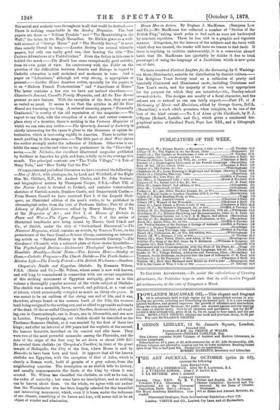Of magazines and periodical literature we have received the following
: —Men of Mark, with photographs, by Lock and Whitfield, of the Right Hon. Mr. Childers, M.P., Dr. Andrew Clarke, and Dr. John Stainer; and biographical notices by Thompson Cooper, F.S.A.—Part VIL of Our Native Land is devoted to Ireland, and contains water-colour sketches of Carrick-a-rede, DanInce Castle, and Dunseverick Castle.— From Messrs. Cassell we have received Part I. of the Leopold Shak- spere, an illustrated edition of the poet's works, to be published in chronological order, from the text of Professor Delius ; Part 42 of the Library of English Literature, edited by Henry Morley ; Part VI. of the Magazine of Art ; and Part I. of Heroes of Britain in Peace and War.—The Upper Engadine, No. 8 of the series of illustrated handbooks now being issued by Messrs. Orell Fusili and Co., of Zurich, under the title of "Switzerland Mustrated."—The Nautical Magazine, which contains an article, by Travers Ts% iss, on the protectorate of the Suez Canal.—Science Gossip, containing an interest- ing article on "Natural History in the Seventeenth Century."—The Gardeners' Chronicle, with a coloured plate of three choice hyacinths.— The Psychological Review.—L)ickenson's Theological Quarterly.—The Homiletic Monthly.—Social Notes.—The Leisure Hour.—Sunday at Home.—Catholic Progress.—The Church Builder.—The Truth-Seeker.- Mission Life.—The Family Friend.—The British Workman.—Sunshine. Cleopatra's Needle and Egyptian Obelisks. By Erasmus Wilson, F.R.S. (Brain and Co.)—Mr. Wilson, whose name is now well known, and will long be remembered in connection with our recent acquisition of this striking monument of Egyptian antiquity, gives us in this volume a thoroughly popular account of, the whole subject of Obelisks. The obelisk was a monolith, hewn, carved, and polished, at a vast cost of labour, which occasionally occupied as much as thirty-six years. It was meant to be an emblem of the rising sun and of life, and it was, therefore, always found on the eastern bank of the Nilo, the western bank being assigned to the setting sun, and so allied to pyramids and tombs of the dead. Of the so-called Cleopatra's Needles, there are four, all stand- ing, one in Constantinople, one in Rome, one in Alexandria, and one now in London. Properly speaking, our Obelisk should be described as the Thothmes-Rameses Obelisk, as it was erected by the first of these two


































 Previous page
Previous page